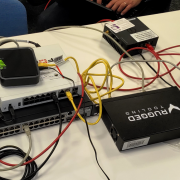Paper presentations at four conferences
We congratulate our colleagues from Fraunhofer AISEC for four paper presentations at academic conferences within the past months! Click on the titles below for more information on each paper.
1. "Optimizing infomation loss toward robust neural networks"
This paper was presented at the DYNAMICS workshop on the 7th of December 2020 at the Annual Computer Security Applications Conference (ACSAC). The paper proposes a novel method to make deep learning models robust, which can be applied on different data sets, such as images, audios, languages. The results show this method is comparable to adversarial training method.
The paper is available to download here.
Authors: Philip Sperl and Konstantin Böttinger
Abstract: Neural Networks (NNs) are vulnerable to adversarial examples. Such inputs differ only slightly from their benign counterparts yet provoke misclassifications of the attacked NNs. The required perturbations to craft the examples are often negligible and even human imperceptible. To protect deep learning-based systems from such attacks, several countermeasures have been proposed with adversarial training still being considered the most effective. Here, NNs are iteratively retrained using adversarial examples forming a computational expensive and time consuming process often leading to a performance decrease. To overcome the downsides of adversarial training while still providing a high level of security, we present a new training approach we call \textit{entropic retraining}. Based on an information-theoretic-inspired analysis, entropic retraining mimics the effects of adversarial training without the need of the laborious generation of adversarial examples. We empirically show that entropic retraining leads to a significant increase in NNs’ security and robustness while only relying on the given original data. With our prototype implementation we validate and show the effectiveness of our approach for various NN architectures and data sets.
2. "Visualizing Automatic Speech Recognition"
The second paper was also presented at the Annual Computer Security Applications Conference (ACSAC) 2020. The authors apply two visualization techniques to the ASR system Deepspeech and show significant visual differences between benign data and adversarial examples.
Authors: Karla Markert, Romain Parracone, Philip Sperl and Konstantin Böttinger.
Abstract: Security of automatic speech recognition (ASR) is becoming ever more important as such systems increasingly influence our daily life, notably through virtual assistants. Most of today’s ASR systems are based on neural networks and their vulnerability to adversarial examples has become a great matter of research interest. In parallel, the research for neural networks in the image domain has progressed, including methods for explaining their predictions. New concepts, referred to as attribution methods, have been developed to visualize regions in the input domain that strongly influence the image’s classification. In this paper, we apply two visualization techniques to the ASR system Deepspeech and show significant visual differences between benign data and adversarial examples. With our approach we make first steps towards explaining ASR systems, enabling the understanding of their decision process.
3. “Adversarial Attacks on Speech Recognition Systems: Language Bias in Literature”
The third paper was presented at the 4th ACM Computer Science in Cars Symposium (ACM CSCS 2020). This paper provides a short overview on recent literature to discuss the language bias towards English in current research. The preliminary findings underline that there are differences in the vulnerability of a German and an English ASR system.
Authors: Karla Markert, Donika Mirdita and Konstantin Böttinger
Abstract: Voice control systems in vehicles offer great advantages for drivers, in particular more comfort and increased safety while driving. Being continuously enhanced, they are planned to comfortably allow access to the networked home via external interfaces. At the same time, this far-reaching control enables new attack vectors and opens doors for cyber criminals. Any attacks on the voice control systems concern the safety of the car as well as the confidentiality and integrity of the user’s private data. For this reason, the analysis of targeted attacks on automatic speech recognition (ASR) systems, which extract the information necessary for voice control systems, is of great interest. The literature so far has only dealt with attacks on English ASR systems. Since most drivers interact with the voice control system in their mother tongue, it is important to study language-specific characteristics in the generation of so-called adversarial examples: manipulated audio data that trick ASR systems. In this paper, we provide a short overview on recent literature to discuss the language bias towards English in current research. Our preliminary findings underline that there are differences in the vulnerability of a German and an English ASR system.
4. “DLA: dense layer analysis for adversarial example detection”
This paper was already presented at the IEEE European Symposium on Security and Privacy 2020 in September. It proposes an adversarial example detector by analysing dense layer activations of deep learning models.
The paper is available to download here.
Authors: Philip Sperl, Ching-Yu Kao, Peng Chen, Xiao Lei, and Konstantin Boettinger
Abstract: In this paper, we present a novel end-to-end framework to detect such attacks during classification without influencing the target model’s performance. Inspired by recent research in neuron-coverage guided testing we show that dense layers of DNNs carry security-sensitive information. With a secondary DNN we analyze the activation patterns of the dense layers during classification runtime, which enables effective and real-time detection of adversarial examples. This approach has the advantage of leaving the already trained target model and its classification accuracy unchanged. Protecting vulnerable DNNs with such detection capabilities significantly improves robustness against state-of-the-art attacks.Our prototype implementation successfully detects adversarial examples in image, natural language, and audio processing. Thereby, we cover a variety of target DNNs, including Long Short Term Memory (LSTM) architectures. In addition to effectively defend against state-of-the-art attacks, our approach generalizes between different sets of adversarial examples. Thus, our method most likely enables us to detect even future, yet unknown attacks.






 https://pixabay.com/photos/writing-write-person-paperwork-828911/
https://pixabay.com/photos/writing-write-person-paperwork-828911/ 


